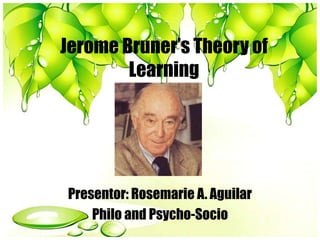Jerome bruner’s theory of learning
•Download as PPTX, PDF•
20 likes•10,694 views
Theory of Learning
Report
Share
Report
Share

Recommended
Recommended
More Related Content
What's hot
What's hot (20)
Transfer of learning - – types of transfer – teaching for positive transfer

Transfer of learning - – types of transfer – teaching for positive transfer
Learning Process: Behaviorism, Cognitivism and Constructivism

Learning Process: Behaviorism, Cognitivism and Constructivism
Information Processing Model and its implications in learning and teaching

Information Processing Model and its implications in learning and teaching
Similar to Jerome bruner’s theory of learning
Similar to Jerome bruner’s theory of learning (20)
Guided discovery approch in science learning theory and

Guided discovery approch in science learning theory and
More from Golden Success College
More from Golden Success College (16)
Social Welfare Social Development and Sustainable DEv

Social Welfare Social Development and Sustainable DEv
social welfare, social development and sustainable development.pptx

social welfare, social development and sustainable development.pptx
Social Welfare,Social development,Sustainable Development.pptx

Social Welfare,Social development,Sustainable Development.pptx
Pangangailangan-at-kagustuhan (Cooperative Learning).pptx

Pangangailangan-at-kagustuhan (Cooperative Learning).pptx
21st Century Literature from the Philippines and the World

21st Century Literature from the Philippines and the World
Literary Genres and their Elements, Structures,.pptx

Literary Genres and their Elements, Structures,.pptx
Recently uploaded
Recently uploaded (20)
Food safety_Challenges food safety laboratories_.pdf

Food safety_Challenges food safety laboratories_.pdf
Unit-IV; Professional Sales Representative (PSR).pptx

Unit-IV; Professional Sales Representative (PSR).pptx
Basic Civil Engineering first year Notes- Chapter 4 Building.pptx

Basic Civil Engineering first year Notes- Chapter 4 Building.pptx
This PowerPoint helps students to consider the concept of infinity.

This PowerPoint helps students to consider the concept of infinity.
Micro-Scholarship, What it is, How can it help me.pdf

Micro-Scholarship, What it is, How can it help me.pdf
UGC NET Paper 1 Mathematical Reasoning & Aptitude.pdf

UGC NET Paper 1 Mathematical Reasoning & Aptitude.pdf
Unit-V; Pricing (Pharma Marketing Management).pptx

Unit-V; Pricing (Pharma Marketing Management).pptx
ICT Role in 21st Century Education & its Challenges.pptx

ICT Role in 21st Century Education & its Challenges.pptx
Python Notes for mca i year students osmania university.docx

Python Notes for mca i year students osmania university.docx
On National Teacher Day, meet the 2024-25 Kenan Fellows

On National Teacher Day, meet the 2024-25 Kenan Fellows
Jerome bruner’s theory of learning
- 1. Jerome Bruner’s Theory of Learning Presentor: Rosemarie A. Aguilar Philo and Psycho-Socio
- 2. Principles of J. Bruner Theory 1. Instruction must be concerned with the experiences and contexts that make the student willing and able to learn (readiness).
- 3. Principles of J. Bruner Theory 2. Instruction must be structured so that it can be easily grasped by the student (spiral organization).
- 4. Principles of J. Bruner Theory 3. Instruction should be designed to facilitate extrapolation and or fill in the gaps (going beyond the information given).
- 5. J. Bruner Theory *Bruner's theoretical framework is based on the theme that learning is an active process and learners construct new ideas or concepts based upon existing knowledge.
- 6. J. Bruner Theory *Facets of the process include selection and transformation of information, decision making, generating hypotheses, and making meaning from information and experiences.
- 7. J. Bruner Theory *Cognitive structure (i.e., schema, mental models) provides meaning and organization to experiences and allows the individual to "go beyond the information given".
- 8. J. Bruner Theory *He investigated motivation for learning. He felt that ideally, interest in the subject matter is the best stimulus for learning. Bruner did not like external competitive goals such as grades or class ranking.
- 9. J. Bruner's Theory of Instruction 1. Tendency towards learning. 2. The ways in which a body of knowledge can be structured so that it can be most readily grasped by the learner, 3. The most effective sequences in which to present material. 4. The nature and pacing of rewards and punishments.
- 10. Bruner: Learning must be ACTIVE! Like Piaget, Bruner believed in stages of instruction based on development. *Cognitive Growth a. enactive (birth to age 3) b. iconic (age 3 to 8) c. symbolic (from age 8) *Discovery Learning
- 14. Spiral Curriculum Instead of focusing for relatively long periods of time on specific narrow topics, a spiral curriculum tries to expose students to a wide varies of ideas over and over ago.
- 15. Classroom Instruction *Provide study materials, activities and tools. *Examples of all three to help children learn about dinosaurs -Construct a model of a dinosaur (enactive) -Watch a film about dinosaurs (iconic) -Consult reference texts and discuss
- 16. Scaffolding Theory He used the term to describe young children's oral language acquisition. Helped by their parents when they first start learning to speak, young children are provided with instinctive structures to learn a language. Bed-time stories and read alouds are classic examples.
- 17. Conclusion of Theory 1. A major theme in the theoretical framework of Bruner is that learning is an active process in which learners construct new ideas or concepts based upon their current/past knowledge. 2. As far as instruction is concerned, the instructor should try and encourage students to discover principles by themselves and they should engage in an active dialogue. (i.e., socratic learning). 3. Curriculum should be organized in a spiral manner so that the student continually builds upon what they have already learned.
